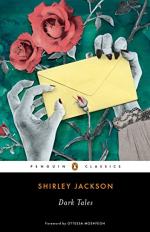
|
| Name: _________________________ | Period: ___________________ |
This test consists of 15 multiple choice questions and 5 short answer questions.
Multiple Choice Questions
1. When Miss Strangeworth thinks to herself "People must live graciously, after all," (425), what does this show about her as a person?
(a) She understands very little about other people.
(b) She is a very selfish person.
(c) She understands the irony of her position in the town.
(d) She wants everyone to have a life as nice as hers.
2. What detail is included to show that Miss Chandler is upset about something?
(a) Her hair does not look as neat as usual.
(b) She looks as if she has not slept well.
(c) She seems distracted and is a little rude.
(d) She has clearly been crying.
3. According to the narrator, how do the townspeople feel about Miss Strangeworth and her house and her roses?
(a) Proud.
(b) Irritated.
(c) Amused.
(d) Jealous.
4. What does Miss Strangeworth tell Helen Crane about her worries?
(a) She should talk with her husband.
(b) They are just another example of the anxieties Helen has always had.
(c) All babies develop differently.
(d) She should talk with her baby's doctor.
5. Miss Strangeworth thinks about the Cranes "indulgently" (421). How does she think about them?
(a) In the surprised way that an adult looks at a child that has done something strange.
(b) With the scorn that people show towards those who eat, drink, or do other things to excess.
(c) In the forgiving but irritated way that an adult looks at a misbehaving child.
(d) With the kindness that a person shows to someone who needs a little extra generosity or lenience.
6. What does Miss Strangeworth fail to notice about her letters?
(a) She has forgotten to address one.
(b) The envelopes are not properly sealed.
(c) They do not have stamps on them.
(d) One has fallen onto the ground.
7. Who is the author of "The Possibility of Evil"?
(a) Flannery O'Connor.
(b) Katherine Anne Porter.
(c) Shirley Jackson.
(d) Henry James.
8. Why does Miss Strangeworth think that she has a right to eavesdrop on Linda Stewart at the post office?
(a) It is "her" town and she needs to know if "her" people are in trouble.
(b) She means to help Linda with her troubles.
(c) She knows Linda's parents well.
(d) It is a public place.
9. What is the purpose of including the details about how many people Miss Strangeworth talks to on her trip to the grocery store?
(a) It shows that Miss Strangeworth is a helpful and kind neighbor.
(b) It shows that the townspeople like and trust her.
(c) It shows that Miss Strangeworth is nosy.
(d) It shows that the townspeople all need something from Miss Strangeworth.
10. According to Miss Strangeworth, to whom should Helen apologize?
(a) Her husband.
(b) The baby.
(c) Miss Strangeworth.
(d) Her mother.
11. What literary technique is used when Miss Strangeworth asks Helen if she has upset her husband by pointing out that the baby is " six months old and hasn't yet begun to learn to dance"?
(a) Simile.
(b) Imagery.
(c) Hyperbole.
(d) Personification.
12. Why does Miss Strangeworth fail to notice the important detail about her letters?
(a) She notices that a car has turned down the street and is getting close.
(b) She is busy thinking about sending a letter to Dave Harris's father.
(c) One of the younger children bumps into her.
(d) Linda Stewart begins sobbing again.
13. Who is the original owner of Miss Strangeworth's house?
(a) Miss Strangeworth.
(b) Her grandfather.
(c) Her father.
(d) Her great-grandfather.
14. What are the youngest children at the post office doing?
(a) Jumping rope.
(b) Playing tag.
(c) Playing with a puppy.
(d) Roller skating.
15. Helen Crane looks at her baby with "rapt wonder" (421). How is she looking at the baby?
(a) With a startled, questioning look.
(b) With all of her attention on something amazing.
(c) With a focused suspicion.
(d) With a puzzled, pinched look.
Short Answer Questions
1. When does Miss Strangeworth generally mail her letters?
2. What do the people in town decide is wrong with Linda Stewart after they realize that she has not had a fight with her boyfriend?
3. Miss Strangeworth thinks that people everywhere are "degraded" (425). What does this mean that she thinks about people?
4. What business did Miss Strangeworth's grandfather run?
5. What is the best definition of "proverbial" in the sentence "Miss Strangeworth's hats were proverbial in the town" (426)?
|
This section contains 821 words (approx. 3 pages at 300 words per page) |

|




